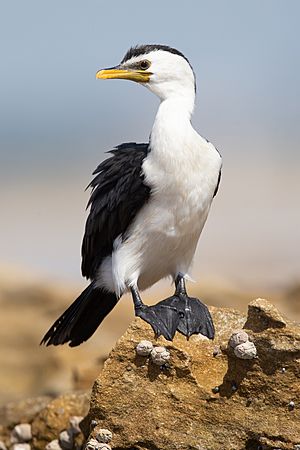Little pied cormorant facts for kids
Quick facts for kids Little pied cormorant |
|
|---|---|
 |
|
 |
|
| Conservation status | |
| Scientific classification | |
| Genus: |
Microcarbo
|
| Species: |
melanoleucos
|
 |
|
| Range of the little pied cormorant | |
| Synonyms | |
|
Phalacrocorax melanoleucos |
|
The little pied cormorant is a common waterbird found in Australia, New Zealand, and nearby islands. It's also known as the little shag or kawaupaka. This small bird usually has a black back and white belly. It has a yellow bill and a small crest of feathers. In New Zealand, you might see a form that is mostly black with a white throat.
Contents
What is a Little Pied Cormorant?
This bird is known by different names depending on where you are. In Australia, it's called the little pied cormorant. In New Zealand, people call it the little shag or by its Māori name, kawaupaka. The name "white-throated shag" is used for the all-black version found there.
The little pied cormorant was first described by a French scientist named Louis Jean Pierre Vieillot in 1817. Scientists group animals together based on their features. This bird belongs to a group of "micro-cormorants." The name Microcarbo comes from ancient Greek and Latin words meaning "small black."
There are three main types, or subspecies, of the little pied cormorant:
- M. m. melanoleucos: This type lives across most of the bird's range, except for New Zealand and some sub-Antarctic islands.
- M. m. brevicauda Mayr 1931: This type is found only on Rennell Island in the Solomon Islands.
- M. m. brevirostris Gould 1837 (little shag): This type lives in New Zealand and is also seen on sub-Antarctic islands. It has even bred on Campbell Island.
What Does it Look Like?
The little pied cormorant is a small bird, about 56 to 58 centimeters (22 to 23 inches) long. It has a short bill, about 3 centimeters (1.2 inches) long, and a longer tail. It also has a small black crest on its head.
These birds can look different depending on their "morph" or color type. Most little pied cormorants are "pied," meaning they are glossy black on top and white underneath. Their face, belly, and thighs are white. Their bill and the skin around their face are yellow.
However, in New Zealand, a mostly black type is more common. This "melanistic" morph is black all over with a greenish shine. Only the sides of its head, chin, throat, and upper neck are white. Its bill is yellow with black on top. You might also see birds with mixed colors.
In both color types, the legs and feet are black. The pied form is rare in New Zealand, but it's more common in the Northland region.
Baby cormorants have dark brown fluffy feathers. Young birds are a dull blackish-brown. Pied young birds have lighter underparts. When little pied cormorants are looking for a mate, they make a soft cooing sound.
It can be confused with other cormorants. The black-faced cormorant is a bit bigger. The Australian pied cormorant is much larger.
Where Do They Live?
The little pied cormorant lives across New Zealand, from Stewart Island to Northland. It also lives across mainland Australia, Tasmania, and Indonesia. However, you won't find it in the dry, desert-like parts of western Australia.
These birds are common and widespread. They like to live near water. You can find them in swamps, lakes, lagoons, estuaries (where rivers meet the sea), and along the coastline.
How Do They Find Food?
The little pied cormorant is a "benthic feeder." This means it finds its food on the bottom of the water. It usually hunts alone in shallow water, often close to the shore.
When it dives for food, it stays underwater for about 15 to 20 seconds. It then comes up to the surface for 5 to 10 seconds to rest or swallow its prey. It eats many different kinds of fish. It also eats a lot of crustaceans, like crabs or shrimp. In New Zealand, it often eats local flounder and other small flatfish. Eels and insect larvae are also part of its diet.
The cormorant brings its food to the surface to swallow it. Sometimes, it will put a fish down on the water to turn it around. This helps it swallow the fish headfirst. Because of this habit, other birds, like red-billed gulls, sometimes try to steal their food.
Reproduction and Life Cycle
Little pied cormorants usually breed once a year. In southern areas like southern Australia and New Zealand, this happens in spring or early summer. In tropical areas, they breed after the monsoon season.
Their nest is like a platform made of branches and sticks. They often build it in the forks of trees that are standing in water, especially eucalyptus trees. These nests are often found near other waterbirds, such as other cormorants, herons, ibises, or spoonbills.
A female cormorant lays four or five pale blue oval eggs. Each egg is about 46 by 31 millimeters (1.8 by 1.2 inches). The eggs have a thin layer of a chalky material, which makes them look matte white. As the breeding season goes on, the eggs and nest can get stained with bird droppings.
Gallery
See also
 In Spanish: Cormorán piquicorto para niños
In Spanish: Cormorán piquicorto para niños







